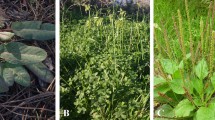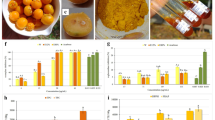Abstract
Chiltepin, a wild chili mostly used in different traditional foods and traditional medicine in Northwest Mexico, represents a source of polyphenols. However, studies about the bioaccessibility of polyphenols as a parameter to measure the nutritional quality and bioefficacy of them in the fruit after consumption are scarce. Chiltepin showed phenolic acids and flavonoids contents between 387 and 65 μg/g, respectively. Nevertheless, these values decreased after the digestion process. Before digestion, gallic acid, 4-hydroxibenzoinc acid, chlorogenic acid, caffeic acid, p-coumaric acid, quercetin and luteolin were the main polyphenols found in chiltepin by HPLC-DAD and confirmed by FIA-ESI-IT-MS/MS. Gallic and chlorogenic acids were non-detected in the gastric phase, while only p-coumaric acid (5.35 ± 3.89 μg/g), quercetin (5.91 ± 0.92 μg/g) and luteolin (2.86 ± 0.62 μg/g) were found in the intestinal phase. The bioaccessibility of phenolic acids, flavonoids, and total polyphenols after the intestinal phase was around 24, 17 and 23%, respectively. Overall, results indicated that release of polyphenols from chiltepin fruit might be affected by the food matrix and gastrointestinal conditions due to the low bioaccessibility values observed.
Similar content being viewed by others
References
Materska M, Perucka I (2005) Antioxidant activity of the main phenolic compounds isolated from hot pepper fruit (Capsicum annuum L.). J Agric Food Chem 53(5):1750–1756. https://doi.org/10.1021/jf035331k
Hayano-Kanashiro C, Gamez-Meza N, Medina-Juárez LA (2016) Wild pepper Capsicum annuum L. var. glabriusculum: taxonomy, plant morphology, distribution, genetic diversity, genome sequencing, and phytochemical compounds. Crop Sci 56(1):1–11. https://doi.org/10.2135/cropsci2014.11.0789
Hervert-Hernández D, Sáyago-Ayerdi SG, Goñi I (2010) Bioactive compounds of four hot pepper varieties (Capsicum annuum L.), antioxidant capacity, and intestinal bioaccessibility. J Agric Food Chem 58(6):3399–3406. https://doi.org/10.1021/jf904220w
Velderrain-Rodríguez GR, Palafox-Carlos H, Wall-Medrano A, Ayala-Zavala JF, Chen CYO, Robles-Sánchez M, Astiazaran-García H, Alvarez-Parrilla E, González-Aguilar GA (2014) Phenolic compounds: their journey after intake. Food Funct 5(2):189–197. https://doi.org/10.1039/C3FO60361J
González-Casado S, Martín-Belloso O, Elez-Martínez P, Soliva-Fortuny R (2018) Application of pulsed electric fields to tomato fruits for enhancing the bioaccessibility of carotenoids in derived products. Food Funct. https://doi.org/10.1039/C7FO01857F
Juániz I, Ludwig IA, Bresciani L, Dall'Asta M, Mena P, del Rio D, Cid C, de Peña MP (2016) Catabolism of raw and cooked green pepper (Capsicum annuum) (poly) phenolic compounds after simulated gastrointestinal digestion and fecal fermentation. J Funct Foods 27:201–213. https://doi.org/10.1016/j.jff.2016.09.006
Goñi I, Díaz-Rubio ME, Pérez-Jiménez J, Saura-Calixto F (2009) Towards an updated methodology for measurement of dietary fiber, including associated polyphenols, in food and beverages. Food Res Int 42(7):840–846. https://doi.org/10.1016/j.foodres.2009.03.010
Saura-Calixto F (2011) Dietary fiber as a carrier of dietary antioxidants: an essential physiological function. J Agric Food Chem 59(1):43–49. https://doi.org/10.1021/jf1036596
Saura-Calixto F, García-Alonso A, Goñi I, Bravo L (2000) In vitro determination of the indigestible fraction in foods: an alternative to dietary fiber analysis. J Agric Food Chem 48(8):3342–3347. https://doi.org/10.1021/jf0000373
Karadag A, Ozcelik B, Saner S (2009) Review of methods to determine antioxidant capacities. Food Anal Method 2(1):41–60. https://doi.org/10.1007/s12161-008-9067-7
Rochín-Wong C, Gámez-Meza N, Montoya-Ballesteros L, Medina-Juárez L (2013) Effect of drying and pickling processes on antioxidant capacity of phytochemicals of chiltepin (Capsicum annuum L. var. glabriusculum). Rev Mex Ing Quim 12(2):227–239. http://www.scielo.org.mx/scielo.php?script=sci_arttext&pid=S1665-27382013000200004&lng=es&tlng=es
Craft BD, Kerrihard AL, Amarowicz R, Pegg RB (2012) Phenol-based antioxidants and the in vitro methods used for their assessment. Compr Rev Food Sci Food Saf 11(2):148–173. https://doi.org/10.1111/j.1541-4337.2011.00173.x
Kamiloglu S, Capanoglu E, Bilen FD, Gonzales GB, Grootaert C, van de Wiele T, van Camp J (2016) Bioaccessibility of polyphenols from plant-processing byproducts of black carrot (Daucus carota L.). J Agric Food Chem 64(12):2450–2458. https://doi.org/10.1021/acs.jafc.5b02640
Blanco-Ríos AK, Medina-Juárez LA, González-Aguilar GA, Gámez-Meza N (2013) Antioxidant activity of the phenolic and oily fractions of different sweet bell peppers. J Mex Chem Soc 57(2):137–143. http://www.scielo.org.mx/scielo.php?script=sci_arttext&pid=S1870-249X2013000200011&lng=es
Kaulmann A, André CM, Schneider Y-J, Hoffmann L, Bohn T (2016) Carotenoid and polyphenol bioaccessibility and cellular uptake from plum and cabbage varieties. Food Chem 197:325–332. https://doi.org/10.1016/j.foodchem.2015.10.049
Mosele JI, Macià A, Romero M-P, Motilva M-J (2016) Stability and metabolism of Arbutus unedo bioactive compounds (phenolics and antioxidants) under in vitro digestion and colonic fermentation. Food Chem 201:120–130. https://doi.org/10.1016/j.foodchem.2016.01.076
Ortega N, Reguant J, Romero M-P, Macià A et al (2009) Effect of fat content on the digestibility and bioaccessibility of cocoa polyphenol by an in vitro digestion model. J Agric Food Chem 57(13):5743–5749. https://doi.org/10.1021/jf900591q
Pellegrini M, Lucas-Gonzalez R, Sayas-Barberá E, Fernández-Lopez J et al (2018) Bioaccesibility of phenolic compounds and antioxidant capacity of chia (Salvia hispanica L.) seeds. Plant Foods Hum Nutr 73(1):47–53. https://doi.org/10.1007/s11130-017-0649-7
Rodriguez-Mateos A, Vauzour D, Krueger CG, Shanmuganayagam D, Reed J, Calani L, Mena P, del Rio D, Crozier A (2014) Bioavailability, bioactivity and impact on health of dietary flavonoids and related compounds: an update. Arch Toxicol 88(10):1803–1853. https://doi.org/10.1007/s00204-014-1330-7
Hollman PCH (2004) Absorption, bioavailability, and metabolism of flavonoids. Pharm Biol 42(sup1):74–83. https://doi.org/10.3109/13880200490893492
Croft KD (2016) Dietary polyphenols: antioxidants or not? Arch Biochem Biophys 595:120–124. https://doi.org/10.1016/j.abb.2015.11.014
Acknowledgements
The authors would like to thank CONACYT (291126-UNISON MOD.ORD./68/2016) for the support given during this research. We also thank to chiltepin farmers: Juan Bautista Teran Fraijo and María del Socorro Fraijo Encinas for the facilities provided to get the wild seeds and fruits of chiltepin.
Author information
Authors and Affiliations
Corresponding authors
Ethics declarations
Conflict of Interest
All the authors declare they have no conflict of interest. This article does not contain any studies with human or animal subjects.
Electronic supplementary material
ESM 1
(DOCX 48 kb)
Rights and permissions
About this article
Cite this article
Ovando-Martínez, M., Gámez-Meza, N., Molina-Domínguez, C.C. et al. Simulated Gastrointestinal Digestion, Bioaccessibility and Antioxidant Capacity of Polyphenols from Red Chiltepin (Capsicum annuum L. Var. glabriusculum) Grown in Northwest Mexico. Plant Foods Hum Nutr 73, 116–121 (2018). https://doi.org/10.1007/s11130-018-0669-y
Published:
Issue Date:
DOI: https://doi.org/10.1007/s11130-018-0669-y




